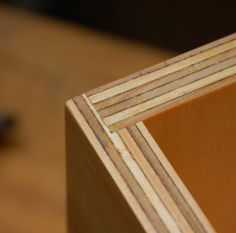dan m
pfm Member
Over the weekend I started to build a simple 60" wide x 15" x 15" cabinet from 3/4" baltic birch. It's not a speaker cab, but for office storage.Things have gone pretty well so far. All pieces are cut and all biscuit holes put in with my Makita plate joiner. It's looking pretty good, and just feels better than getting Ikea foil wrapped particle board boxes. Next I need to glue it up and get a jig to bore out the 35mm holes for 'euro' hinges for the three doors.
So, that's already got me thinking the next projects, which will be record storage - 2 lots of 60" wide x 15" deep x 30" tall, followed by some replacement Klipsch Heresy cabs. For the record cabs I'd like to have the shelves run into dados in the middle and rabbets top and bottom, rather than biscuited butt joints. While I have a small table saw, I think it's just too unwieldy to do those with a dado blade set. For one thing, there's not 15" of room before the blade on the table, and I'd have to build a big dado sled to do it safely for the dados. So, I am thinking a router and track system might be a better solution. Do the woodworking gurus agree? A track system that also mounts a saw would also make crosscutting more accurate and safer.
Any recommendations on a router? What size and feature set would you recommend? The festool is way over budget I'm afraid. I usually buy Makita or Bosch. Thanks for any help!
I'll post pics of the record storage when I start going on it - might prove useful for others.
p.s.
here's a relatively inexpensive track system that could take any make of router: https://www.truetracsaw.com/collections/all
or a Makita rail and guide
p.p.s. I realize to do this with a router I need to get a bit the *exact* dimension of the ply.
So, that's already got me thinking the next projects, which will be record storage - 2 lots of 60" wide x 15" deep x 30" tall, followed by some replacement Klipsch Heresy cabs. For the record cabs I'd like to have the shelves run into dados in the middle and rabbets top and bottom, rather than biscuited butt joints. While I have a small table saw, I think it's just too unwieldy to do those with a dado blade set. For one thing, there's not 15" of room before the blade on the table, and I'd have to build a big dado sled to do it safely for the dados. So, I am thinking a router and track system might be a better solution. Do the woodworking gurus agree? A track system that also mounts a saw would also make crosscutting more accurate and safer.
Any recommendations on a router? What size and feature set would you recommend? The festool is way over budget I'm afraid. I usually buy Makita or Bosch. Thanks for any help!
I'll post pics of the record storage when I start going on it - might prove useful for others.
p.s.
here's a relatively inexpensive track system that could take any make of router: https://www.truetracsaw.com/collections/all
or a Makita rail and guide
p.p.s. I realize to do this with a router I need to get a bit the *exact* dimension of the ply.



